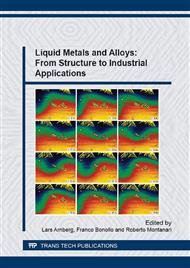[1]
D. Caliari, G. Timelli, F. Bonollo, P. Amalberto, P. Giordano, Fluidity of aluminium foundry alloys: development of a testing procedure, Metall. Ital. 107 (2015) 11-18.
Google Scholar
[2]
M. Çolak, R. Kayikci, D. Dispinar, Fluidity characteristics of A356 alloy with various thickness sectioned new test mould, in: M. Tiryaltioğlu, J. Campbell, G. Byczynski (Eds. ), Shape Casting: 5th International Symposium 2014, TMS 2014, Wiley, 2014, pp.105-112.
DOI: 10.1002/9781118888100.ch13
Google Scholar
[3]
M. Di Sabatino, F. Syvertsen, L. Arnberg, A. Nordmark, An improved method for fluidity measurement by gravity casting of spirals in sand moulds, Int. J. Cast Metals Res. 18 (2005) 59-62.
DOI: 10.1179/136404605225022865
Google Scholar
[4]
M. Di Sabatino, L. Arnberg, S. Brusethaug, D. Apelian, Fluidity evaluation methods for Al-Mg-Si alloys, Int. J. Cast Metals Res. 19 (2006) 94-97.
DOI: 10.1179/136404606225023345
Google Scholar
[5]
H. Kaufmann, W. Fragner, P. J. Uggowitzer, Influence of variations in alloy composition on castability and process stability. Part 1: Gravity and pressure casting processes, Int. J. Cast Metals Res. 18 (2005) 273-278.
DOI: 10.1179/136404605225023054
Google Scholar
[6]
Young-Dong Kwon, Zin-Hyoung Lee, The effect of grain refining and oxide inclusion on the fluidity of Al-4. 5Cu-0. 6Mn and A356 alloys, Mater. Sci. Eng. A 360 (2003) 372-376.
DOI: 10.1016/s0921-5093(03)00504-5
Google Scholar
[7]
G. Timelli, F. Bonollo, Fluidity of aluminium die castings alloy, Int. J. Cast Met. Res. 20 (2007) 304-311.
DOI: 10.1179/136404608x286110
Google Scholar
[8]
M.C. Flemings, Solidification processing, first ed., McGraw-Hill, London, (1974).
Google Scholar
[9]
M. Di Sabatino, L. Arnberg, S. Rørvik, A. Prestmo, The influence of oxide inclusions on the fluidity of Al-7 wt. %Si alloy, Mater. Sci. Eng. A 413-414 (2005) 272-276.
DOI: 10.1016/j.msea.2005.08.175
Google Scholar
[10]
J. Campbell, Complete Casting Handbook - Metal Casting Processes, Metallurgy, Techniques and Design, first ed., Butterworth-Heinemann, Oxford, (2011).
Google Scholar
[11]
M. Tiryakioglu, D.R. Askeland, C.W. Ramsay, The fluidity of 319 and A356: an experimental design approach, AFS Trans. 102 (1994) 17-25.
Google Scholar
[12]
G.L. Squires, Practical physics, fourth ed., Cambridge Univ. Press, Cambridge, (2001).
Google Scholar
[13]
D. Dispinar, J. Campbell, Critical assessment of reduced pressure test. Part 2: Quantification, Int. J. Cast Metals Res. 17 (2004) 287-294.
DOI: 10.1179/136404604225020704
Google Scholar
[14]
D.J. Lloyd, The solidification microstructure of particulate reinforced Al-SiC composites, Comp. Sci. Technol. 35 (1989) 159-179.
DOI: 10.1016/0266-3538(89)90093-6
Google Scholar
[15]
L. Bäckerud, G. Chai, J. Tamminen, Solidification Characteristics of Aluminum Alloys, Vol. 2: Foundry Alloys, first ed., AFS Inc., Des Plaines, IL, (1990).
Google Scholar
[16]
M.B. Djurdjevic, Z. Odanovic, N. Talijan, Characterization of the solidification path of AlSi5Cu(1-4 wt. %) alloys using cooling curve analysis, JOM 63 (2011) 51-57.
DOI: 10.1007/s11837-011-0191-2
Google Scholar
[17]
Z. Guo, N. Saunders, J.P. Schillé, A.P. Miodownik, Material properties for process simulation, Mater. Sci. Eng. A 499 (2009) 7-13.
Google Scholar
[18]
G. Timelli, G. Camicia, S. Ferraro, Effect of grain refinement and cooling rate on the microstructure and mechanical properties of secondary Al-Si-Cu alloys, J. Mater. Eng. Perform. 23 (2014) 611-621.
DOI: 10.1007/s11665-013-0757-y
Google Scholar
[19]
P.R. Beeley, Foundry Technology, second ed., Butterworth-Heinemann, Oxford, (2001).
Google Scholar
[20]
L. Arnberg, L. Bäckerud, G. Chai, Solidification Characteristics of Aluminum Alloys, Vol. 3: Dendrite Coherency, first ed., AFS, Des Plaines, IL, (1996).
Google Scholar


